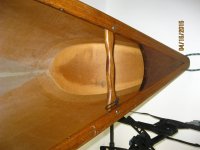Thanks for the replies, Dan your information is very helpful. I wasn't sure about the deck, but your pictures will help me figure out what I need. And with what the others suggested I think I will give the router a try. I have some scrap material I will practice on first,. I have 8 rails 16' long all the same dimensions, so I think if I clamped them together on a long level surface (4 picnic table benches) I could have a nice level surface for the router to ride on.
Now that I know what side (the 3/4") of the rails rides against the canoe I will apply a few coats of varnish to those sides Thanks Phil for reminding me. Today is warm and dry, so I will get one coat on and another tomorrow.
Mike, send me a pm of what you are looking for, I will keep my eye open around here, or just send me a pm when you see something in either Maine or CT, my daughter lives in Camden area of Maine (craigslist/Uncle Henry adds) and I'm there 4-5 times a year and CT/Mass would be easy (unless your looking for the same things I'm always looking for...haha)
Now that I know what side (the 3/4") of the rails rides against the canoe I will apply a few coats of varnish to those sides Thanks Phil for reminding me. Today is warm and dry, so I will get one coat on and another tomorrow.
Mike, send me a pm of what you are looking for, I will keep my eye open around here, or just send me a pm when you see something in either Maine or CT, my daughter lives in Camden area of Maine (craigslist/Uncle Henry adds) and I'm there 4-5 times a year and CT/Mass would be easy (unless your looking for the same things I'm always looking for...haha)

